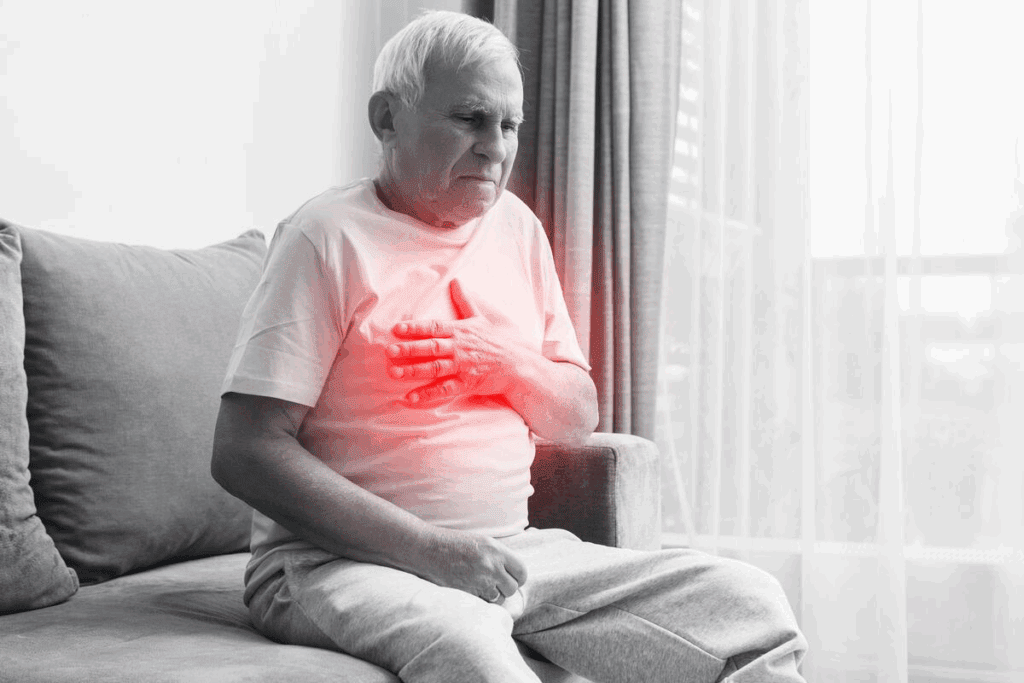Last Updated on October 31, 2025 by Batuhan Temel

Discover angina meaning and 7 key symptoms, including chest pain radiating to neck and jaw.
Chest pain that spreads to your neck, jaw, or arms is a serious warning. At Liv Hospital, we know how vital it is to spot angina symptoms. This condition causes chest pain or discomfort because of less blood to the heart.
We aim to give top-notch care with the newest medical standards. Knowing what angina is all about is key. It usually means there’s a heart issue, like coronary artery disease. Our team works hard to offer the best care and focus on our patients.

To understand angina, we need to know its definition, how it works, and the difference between its stable and unstable forms. Angina is chest pain or discomfort caused by less blood flow to the heart. It’s often a sign of heart disease. Knowing angina what is it and its impact on heart health is key for early treatment.
Angina pectoris, or angina, is chest pain or discomfort due to heart muscle not getting enough oxygen. This happens when the heart’s oxygen needs are not met, usually because of narrowed or spasming heart arteries. It’s vital to grasp what is meaning of angina to understand heart health.
Angina can be stable or unstable, each with its own traits and risks. Stable angina follows a pattern, triggered by activity or stress and eased by rest or meds. Unstable angina, though, is unpredictable and can happen without warning, showing a serious heart issue.
| Characteristics | Stable Angina | Unstable Angina |
| Pattern | Predictable | Unpredictable |
| Triggers | Exertion, Stress | Often occurs at rest |
| Duration | Typically short-lived | Can be prolonged |
| Relief | Relieved by rest or medication | May not be relieved by rest or medication |
Knowing the difference between stable and unstable angina is key to managing it well. It’s also important to recognize when to seek medical help. The importance of angina meaning lies in its role as a warning for heart problems, stressing the need for quick medical check-ups.

Angina affects millions worldwide. Knowing its causes is key to managing it. It’s a sign of a heart problem, often showing as chest pain that spreads to the neck.
Coronary artery disease (CAD) is the main reason for angina. CAD happens when the heart’s blood supply gets cut off. This is due to narrowed or blocked arteries.
Understanding CAD: CAD is when plaque builds up in arteries, making them narrow. It’s called a “silent killer” because it often goes unnoticed until it’s too late.
Many factors can lead to angina. These include smoking, high blood pressure, and high cholesterol. Diabetes, obesity, and a family history of heart disease also play a role. Knowing these risks helps in preventing and managing angina.
| Risk Factor | Description | Impact on Angina |
| Smoking | Damages the inner lining of blood vessels, making them more susceptible to blockage. | Increases the risk of developing angina. |
| High Blood Pressure | Excessive pressure on the blood vessel walls, leading to damage. | Contributes to the narrowing of coronary arteries. |
| High Cholesterol | Excessive cholesterol levels lead to plaque buildup in arteries. | Reduces blood flow to the heart, exacerbating angina symptoms. |
By managing these risks, we can lower the chance and severity of angina. Understanding the causes and risks helps us take care of our hearts better.
Angina is a condition where the heart doesn’t get enough blood. It shows up as chest pain or discomfort. This pain is a big warning that the heart’s blood supply is at risk.
Chest pain can have many causes, but with angina, it has specific signs. Knowing these signs is key to getting help fast.
The chest pain from angina feels like pressure or tightness. It might spread to the arms, neck, or jaw. This pain usually happens when you’re active or stressed and goes away with rest or medicine.
This pain can feel like a heavy weight on your chest, like pain in chest feels like pressure. It’s important to remember that this pain can change in intensity and isn’t always very bad.
Telling angina pain from a heart attack is very important. Both have chest pain, but the pain’s nature and how long it lasts can be different.
Angina pain is predictable and comes from specific things like exercise or stress. It goes away with rest or medicine. Heart attack pain, on the other hand, is unpredictable and can happen when you’re not active. It lasts longer.
Heart attack pain is also often more intense. It can be joined by symptoms like sweating, nausea, or shortness of breath. Knowing these differences helps you get the right medical help.
Also, angina pain can spread to the arm, neck, or jaw, like a heart attack. But, the pattern and what triggers the pain can tell you which it is.
It’s important to know how pain from the heart can spread to the neck and jaw. Angina pectoris, or angina, causes chest pain due to heart disease. This pain can move to the neck and jaw because of the nerves that connect these areas.
The reason for pain in the neck and jaw is the shared nerve roots. The heart gets its nerve supply from the sympathetic nervous system. Nerves from the thoracic spinal cord can send pain to the neck and jaw. This is why angina often feels like pain in these areas.
Spotting tightness in the jaw and chest is key to spotting angina. People often feel a tight or pressured feeling in their chest. This feeling can spread to the jaw and even feel like suffocation.
This feeling of tightness in jaw and chest is a big warning sign of angina. If you feel this, you should get checked by a doctor. They can find out why you’re feeling this way and help you.
In short, pain spreading to the neck and jaw is a big part of angina symptoms. Knowing about the nerves and recognizing the tightness in the jaw and chest helps both patients and doctors. This leads to better heart health for everyone.
Chest pain that goes to the back is often a heart concern. It could be a sign of angina. Knowing the cause and how to tell it from other pains is key for quick treatment.
Referred pain happens when pain feels in a different place than where it is. For angina, this pain in the back comes from shared nerves with the heart. These nerves start from the same spinal area, causing the pain to move.
The complexity of referred pain makes it hard to diagnose. Back pain from muscles can look like heart pain. But, the pain’s details and what triggers it can hint at its cause.
Telling apart heart pain from muscle pain in the back is important. Heart pain from angina comes on with effort or stress and goes away with rest. Muscle pain, on the other hand, gets worse with movement and posture.
Key differences are in when and how the pain happens. Heart pain feels like tightness, while muscle pain is sharp or dull and stays in one spot.
Knowing these differences helps both patients and doctors make the right choices. Spotting angina signs, like back pain from the chest, means getting help fast. This could stop serious problems.
It’s important to know how arm and shoulder pain relates to angina. Angina pectoris, or angina, causes chest pain or discomfort. This pain often spreads to the arms and shoulders.
The left arm is more often affected by angina pain than the right. This is because the left arm is closer to the heart through nerve pathways. But, pain in both arms can be a sign of angina, and it shouldn’t be ignored.
Pain in the left arm is usually more intense because of shared nerve roots with the heart. But, right arm pain can also signal angina. It’s important to investigate cardiac causes when this happens.
The nerves that supply the heart and these areas are connected. This is why angina can cause pain in the chest, shoulders, and arms. This shared nerve supply is the reason for the pain.
Key factors to consider:
Understanding these patterns helps healthcare providers diagnose and manage angina better. This improves patient outcomes.
Angina feels like pressure or tightness in the chest, not sharp pain. This symptom is key to diagnosing angina. It’s important for both patients and doctors to understand this feeling.
The pressure or tightness in angina comes from the heart not getting enough oxygen. This is usually because of blocked or narrowed arteries. The heart muscle sends out a signal of discomfort, which feels like pressure or squeezing.
The reasons for this pressure sensation include:
People with angina often say it feels like tightness or pressure in the chest. This feeling can spread to the neck, jaw, or arms. It can also make breathing short or feel tired.
Patient experiences vary, but common descriptions include:
| Symptom Description | Frequency Reported |
| Chest tightness or pressure | High |
| Neck or jaw pain | Moderate |
| Radiating pain to arms | Moderate |
| Shortness of breath | High |
Knowing about these feelings helps in diagnosing and treating angina. It’s vital for patients to share their experiences with their doctors.
Certain triggers can make angina symptoms worse. It’s important to know and avoid them. This helps manage angina better and improves life quality.
Physical activity is a known angina trigger. When we move more, our heart needs more oxygen. If arteries are narrowed, this can cause chest pain.
Even simple tasks like walking uphill or carrying heavy bags can trigger angina. People with angina should pace themselves and rest often to avoid worsening symptoms.
Stress and anxiety can also trigger angina. Stress makes our heart rate and blood pressure go up. This can strain the heart and cause symptoms.
Relaxation techniques like deep breathing or yoga can help. Talking to mental health experts can also help manage stress-related angina.
Cold weather and heavy meals can also trigger angina. Cold makes blood vessels narrow, reducing heart flow. Heavy meals can also reduce heart flow by increasing blood to the stomach.
Stay warm in cold weather. Eat smaller, lighter meals to manage symptoms better.
By managing these triggers, people with angina can reduce symptoms. This improves their overall life quality.
Knowing when to act fast can save lives. Chest pain with neck and shoulder pain is a serious warning sign. It’s important to recognize these symptoms to avoid serious health issues.
Severe chest pain, pain in the arms or jaw, and shortness of breath need quick medical help. If you see these signs, get help right away.
Acting fast is key if you or someone else has these symptoms. Waiting too long can cause serious harm, like heart damage or even death.
Angina and heart attacks both cause chest pain, but they’re different. Angina happens when you’re active and goes away when you rest. A heart attack can happen anytime and doesn’t get better with rest.
It’s important to know the difference to get the right care. If you’re not sure if it’s angina or a heart attack, it’s safer to go to the emergency room.
| Symptom | Angina | Heart Attack |
| Chest Pain | Typically with exertion, relieved by rest | Can occur at any time, not relieved by rest |
| Radiating Pain | May radiate to neck, jaw, or arms | Often radiates to neck, jaw, or arms |
We know how important it is to know when to go to the emergency room. By knowing the warning signs and the difference between angina and heart attacks, you can protect your health.
It’s important to know how to diagnose and treat angina. This helps manage the condition and improves health outcomes. Doctors use a patient’s medical history, physical exam, and tests to diagnose angina.
Several tests help confirm angina and its severity. These include:
Treatment for angina often combines medicines and lifestyle changes. Medicines may include:
Lifestyle changes are also key. They may include:
In some cases, more invasive treatments are needed. These can include:
Understanding these options helps patients and doctors manage angina well. This improves life quality and reduces risks of complications.
Managing angina well is key to keeping your heart healthy. At Liv Hospital, we teach our international patients about angina and its signs. This helps us give them the best care.
Handling angina means making lifestyle changes, taking medicine, and sometimes surgery. Knowing what causes angina and its signs helps people manage it better.
At Liv Hospital, we aim to give top-notch care to our international patients. We mix medical knowledge with care tailored to each patient. This helps them deal with angina’s challenges.
Living a heart-healthy life, following your medicine, and getting medical help when needed can greatly improve your heart health. We’re here to support our patients in managing angina and improving their heart health.
Angina is a condition where you feel chest pain or discomfort. It happens when your heart doesn’t get enough oxygen-rich blood. This is usually because your coronary arteries are narrowed or blocked.
Angina symptoms include chest pain or discomfort. This pain can spread to your neck, jaw, arms, or back. You might also feel tightness or pressure in your chest or jaw, or a heavy feeling in your chest.
Angina pain is usually triggered by stress or exertion and goes away with rest or medicine. Heart attack pain is more severe, lasts longer, and doesn’t always go away with rest. It can also include symptoms like shortness of breath, nausea, or feeling dizzy.
Angina pain can spread to the neck and jaw because of shared nerve pathways. This referred pain is caused by complex neural connections. It makes you feel pain in one area as if it’s in another.
Angina symptoms can be triggered by physical activity, stress, cold weather, heavy meals, or other factors. Knowing and avoiding these triggers can help manage your angina.
Doctors diagnose angina through your medical history, physical exam, electrocardiogram (ECG), and stress tests. They might also use coronary angiography to check your coronary arteries.
Treatments for angina include lifestyle changes, medicines, and sometimes procedures like angioplasty or CABG. The goal is to reduce symptoms, slow disease progression, and improve your quality of life.
Lifestyle changes are important for managing angina, but they’re often used with medicines and other treatments. Changes include quitting smoking, being more active, eating well, and managing stress.
Seek immediate medical help if you have severe chest pain or discomfort that lasts more than a few minutes. Also, get help if you have trouble breathing, feel dizzy, or if pain spreads to your arm, neck, or jaw.
Stable angina follows a predictable pattern, triggered by exertion or stress, and relieved by rest. Unstable angina is unpredictable, can happen at rest, and may signal a serious condition like a heart attack. Unstable angina needs immediate medical attention.
Angina back pain is often related to exertion or stress and may have other symptoms like chest discomfort. Musculoskeletal back pain is usually related to movement or posture and may be relieved by rest or specific treatments. A doctor can help tell the difference.
Arm and shoulder pain can be a sign of angina due to shared nerve pathways. The pain may be felt in one or both arms and can be accompanied by chest discomfort. Understanding the connection between these areas can help in diagnosis.
World Health Organization. (2025). 7 Key Angina Symptoms Chest Pain Radiating to. Retrieved from https://www.who.int/news-room/fact-sheets/detail/cardiovascular-diseases-(cvds)
Subscribe to our e-newsletter to stay informed about the latest innovations in the world of health and exclusive offers!
WhatsApp us